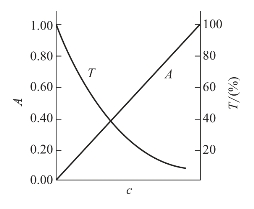光的吸收定律描述了物质吸收光的定量关系,是分光光度法定量分析的基础。

图5-8 溶液对光的吸收程度
当一束单色光垂直照射到任何均匀的非散射介质(固、液、气体)时(图5-8),有一部分被吸收(Ia),一部分透过溶液(It),还有一些部分被样品池表面反射(Ir),若入射光强为Io,则Io=Ia+It+Ir。
由于光垂直照射,同时吸光光度分析中测量时采用的是相同的样品池,反射光Ir很小(Io×4%),且基本不变,即对空白及样品测定时,Ir基本相等,故可忽略其影响,则Io=Ia+It。
溶液对光的吸收程度用吸光度A来表示:

式中:Io——入射光强度;
It——透射光强度。
用透光度T(也称透光率)描述入射光透过溶液的程度:

显然,透光度的取值范围为0~100%。吸光度与透光度的关系为:
![]()
显然,溶液的透光度T越大,表明物质对光的吸收程度越大,即吸光度A越大。吸光度与透光度成负指数关系。图5-9显示了吸光度和透光度与物质的量浓度的关系。
布格(Bouguer)和朗伯(Lambert)先后于1729年和1760年发现了光的吸收程度与吸收层厚度存在正比关系。1852年比尔(Beer)又提出了光的吸收程度和吸收物的浓度也存在正比关系。二者的结合称为朗伯—比尔(Lambert-Beer)定律,其数学表达式为:(www.xing528.com)
![]()

图5-9 吸光度A、透光度T
与物质的量浓度c的关系
式中:A——吸光度;
l——液层厚度,cm;
c——溶液中组分的物质的量浓度,mol·L-1;
k——摩尔吸收系数,L·mol-1·cm-1。
根据朗伯—比尔定律,当波长和吸收池光程一定时,吸光度与浓度呈线性关系,这一关系式只适用于稀溶液。朗伯—比尔定律是吸光光度法的理论基础和定量测定的依据。此定律广泛应用于紫外—可见光、红外光区的吸收测量,不仅适用于溶液,也适用于其他均匀的、非散射的吸光物质(包括气体和液体)。
朗伯—比尔定律的英文描述如下:
The intensity of absorption is given by the Beer-Lambert equation as,

Where I0=intensity of incident radiation;I=intensity of transmitted radiation;A=absorbance (optical density);ε=molar absorptivity (molar extinction coefficient);c=concentration of the solution (g·mol/l)) and l=length of the cell containing solution(in cm).
The plot of curve of molar absorptivity(ε)or logarithm of molar absorptivity(log ε)versus wavelength(λ)constitutes the absorption band.
The absorbance is determined experimentally(A=log I0/I)and the value of molar absorptivity calculated from the above equation.If the value of absorptivity(ε),absorbance and the length of the cell are known,the concentration of the compound can also be determined.This offers a method for the quantitative estimation of compounds in dilute solutions.It should be remembered that the Beer-Lambert equation works accurately only for dilute solutions.
免责声明:以上内容源自网络,版权归原作者所有,如有侵犯您的原创版权请告知,我们将尽快删除相关内容。




